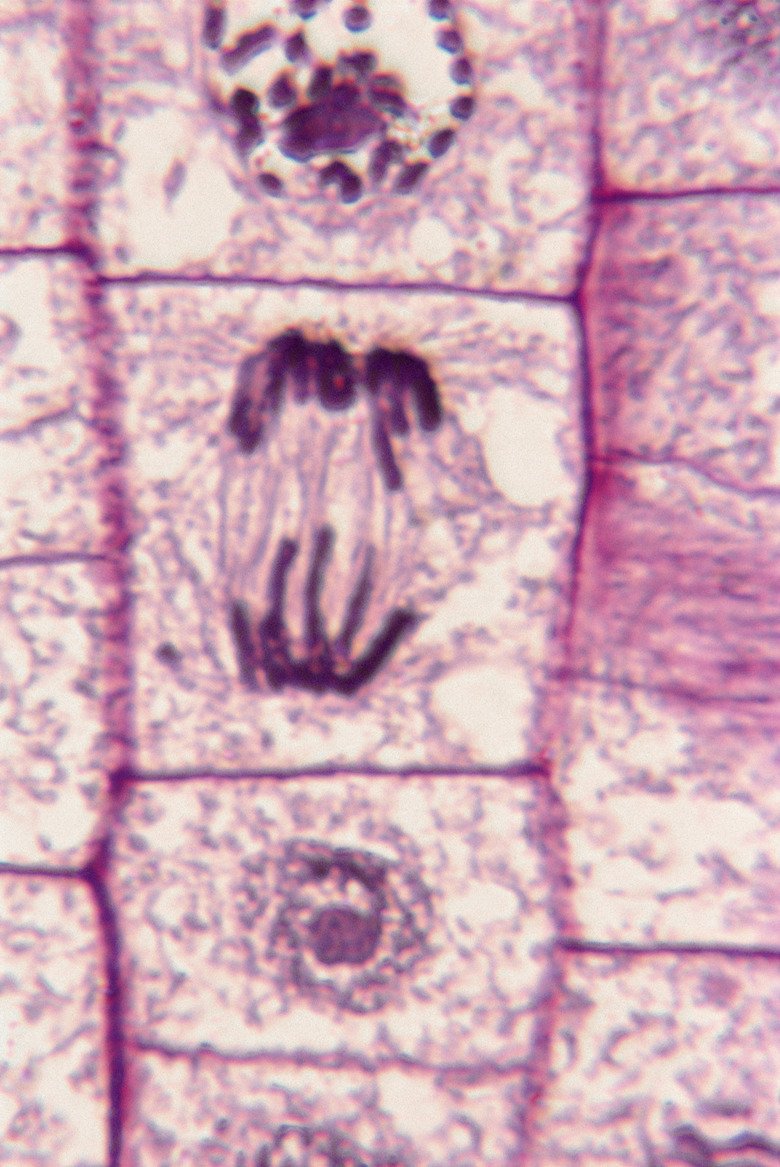What Happens To The Nuclear Envelope During Cytokinesis?
Cytokinesis is the division of one cell into two and is the final step in the cell cycle following the four-stage process of mitosis. During cytokinesis, the nuclear envelope, or nuclear membrane, that encloses the nucleus's genetic material remains unchanged, as it was dissolved and reformed into two separate membranes in an earlier mitosis phase. The nuclear membrane reforms during telophase.
Cytokinesis is the second part of the M phase of the cell cycle, which follows interphase. Interphase itself consists of three sub-stages.
The importance of the nuclear envelope reforming around the new nuclei as telophase comes to a close is that without this happening, a cell could conceivably wind up with two daughter nuclei after cytokinesis while its partner fails to receive one at all. Cell division is a coordinated, elegant process.
Importance of Mitosis
Importance of Mitosis
The ability of cells to divide and replicate through the process of mitosis allows for an organism's growth and repair. Humans can grow, for example, only because their cells are able to replicate. Mitosis also allows multicellular organisms to have cells with specialized functions, such as muscle cells.
Furthermore, mitosis makes possible the repair or replacement of damaged or dead cells. Skin tissue, for example, is constantly regenerating through mitosis, which can repair damage from cuts or abrasions. In simpler creatures, the regenerative benefits of mitosis can result in the regrowth of lost appendages.
Role of the Nuclear Envelope
Role of the Nuclear Envelope
The nuclear envelope is essential to healthy cell function. A membrane of two layers similar to the cell membrane and fused together with nuclear pores, the envelope serves as an essential architectural framework to enclose DNA from the exterior cytoplasm.
At the same time, the envelope serves as gatekeeper for molecules, from proteins to water, which might pass between the nucleus and cytoplasm. The envelope also contributes to important genetic functions, such as DNA replication.
The nuclear envelope contains specific channels called nuclear pores, though which large molecules incapable of simply diffusing across the membrane, such as nucleic acids, can be shuttled. These include mRNA (messenger ribonucleic acid), which is made in the nucleus during transcription and must be moved into the cytoplasm or to the endoplasmic reticulum for translation.
Prophase: The Nuclear Envelope Breaks Down
Prophase: The Nuclear Envelope Breaks Down
The first stage of mitosis, known as prophase, begins as paired copies of DNA, known as sister chromatids, condense within the dividing cell to become visible by microscope. As this condensation begins, the nuclear membrane disappears by dissolving. Since this dissolution ends prophase, some models consider it the beginning of an intermediate prometaphase.
This breakdown of the envelope allows the DNA pairs to align with the central axis, or equatorial plate, of the cell, the key step of the subsequent metaphase. Next, in anaphase, the sister chromatids separate and migrate to opposite ends of the cell, identified by the centrioles.
Telophase, Nuclear Envelope Reformation and Cytokinesis
Telophase, Nuclear Envelope Reformation and Cytokinesis
The result of this separation is two equal sets of DNA grouped at either pole of the cell, making it ready for the reappearance of the nuclear envelope and coinciding with the final stage of mitosis, called telophase.
The nuclear membrane reforms during telophase around each new bundle of DNA, creating two independent nuclei and triggering the cytokinetic division of the parent cell into two new daughter cells.
Cytokinesis actually begins during anaphase of mitosis, with the pinching inward of the cytoplasm from opposite ends of the cell (ends that correspond to the edges the metaphase plate and the plane of cell division).
This makes sense, for as the sister chromatids are pulled apart in this stage, a boundary layer can start to enclose the entire set of chromosomes on either side of the now about-to-split-in-the-cell.
References
- The University of Arizona Biology Project: The Cell Cycle & Mitosis Tutorial
- Molecular Cell Biology (4th Edition): Muscle: A Specialized Contractile Machine H Lodish et al.
- Florida State University Cell Biology and Microscopy: The Nuclear Envelope
- Georgia State University: Cell Nucleus and Nuclear Envelope
- US National Library of Medicine/Journal of Pediatric Research: Nuclear Envelopathies – Raising the Nuclear Veil; R. Somech et al.
Cite This Article
MLA
Siskin, Teresa J.. "What Happens To The Nuclear Envelope During Cytokinesis?" sciencing.com, https://www.sciencing.com/happens-nuclear-envelope-during-cytokinesis-23805/. 19 June 2019.
APA
Siskin, Teresa J.. (2019, June 19). What Happens To The Nuclear Envelope During Cytokinesis?. sciencing.com. Retrieved from https://www.sciencing.com/happens-nuclear-envelope-during-cytokinesis-23805/
Chicago
Siskin, Teresa J.. What Happens To The Nuclear Envelope During Cytokinesis? last modified March 24, 2022. https://www.sciencing.com/happens-nuclear-envelope-during-cytokinesis-23805/
